1993 CADILLAC FLEETWOOD tires
[x] Cancel search: tiresPage 218 of 386
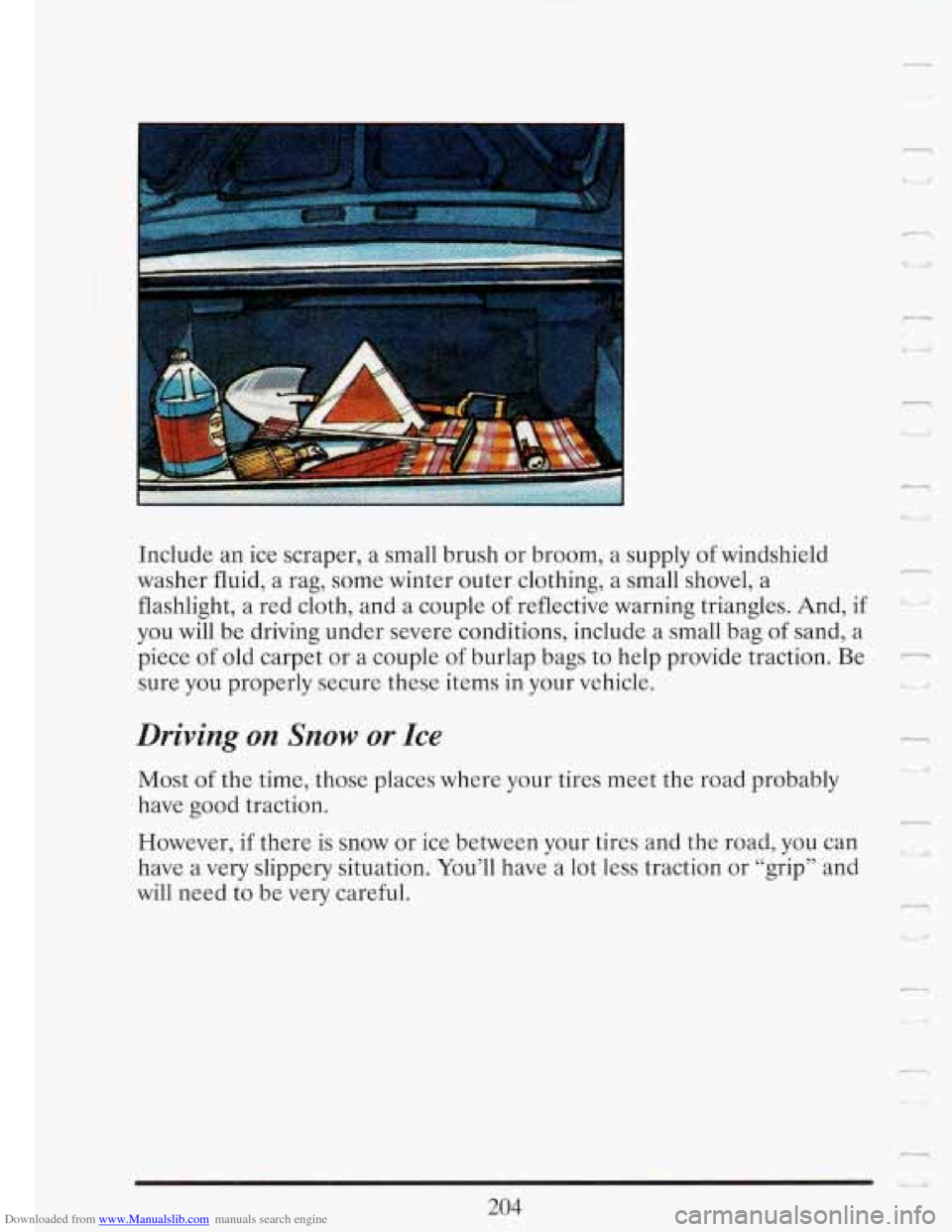
Downloaded from www.Manualslib.com manuals search engine 4
n
Include an ice scraper, a small brush or broom, a supply of windshield
washer fluid, a rag, some winter outer clothing, a small shovel, a
flashlight, a red cloth, and a couple of reflective warning triangles. And,
if ' -
you will be driving under severe conditions, include a small bag of sand, a
piece of old carpet or a couple of burlap bags to help provide traction. Be
-
sure you properly secure these items in your vehicle.
n
Driving on Snow or Ice F
Most of the time, those places where your tires meet the road probably
have good traction.
However,
if there is snow or ice between your tires and the road, you can
have a
very slippery situation. You'll have a lot less traction or "grip" and
will need
to be very careful.
c_
204
Page 219 of 386
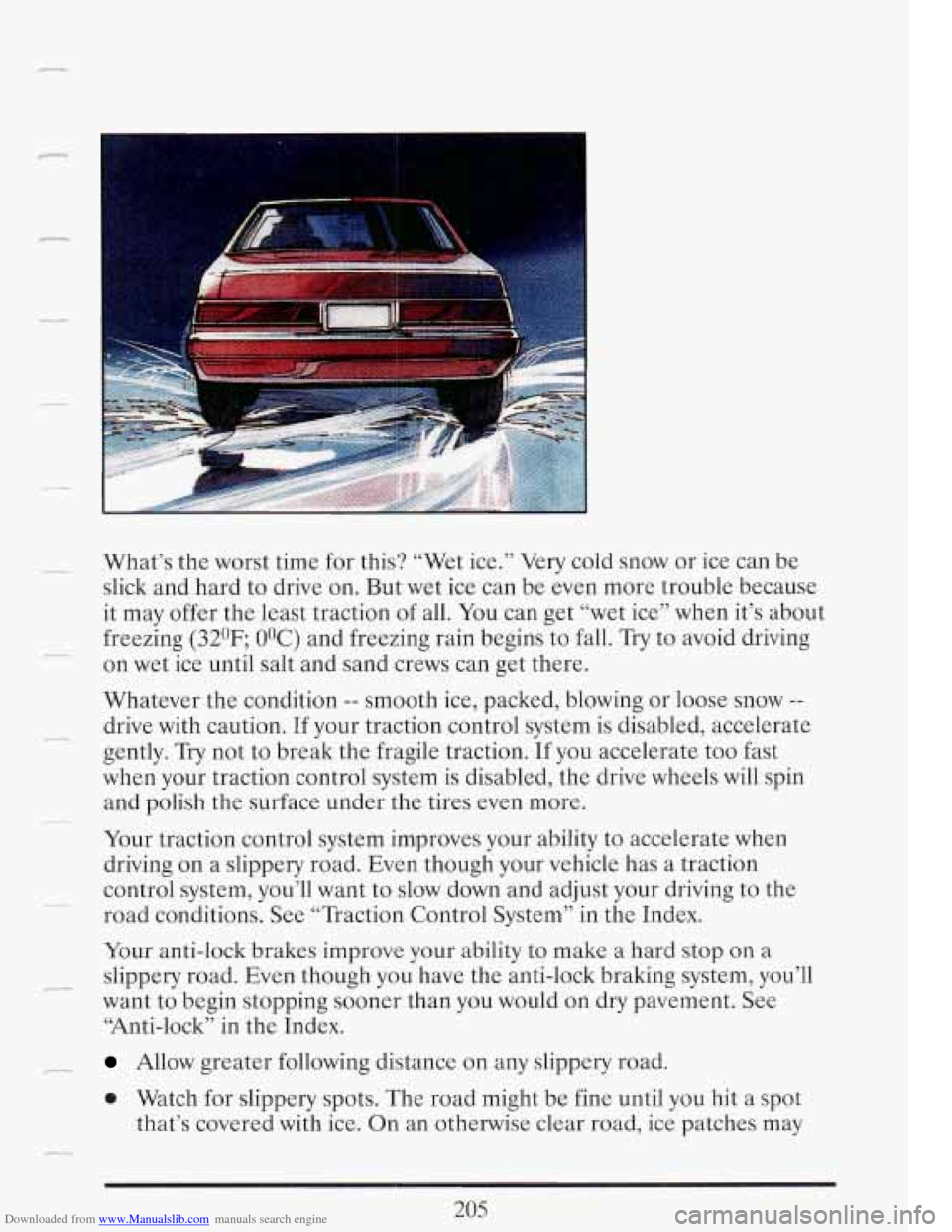
Downloaded from www.Manualslib.com manuals search engine I
- What’s the worst time for this? “Wet ice.” Very cold snow or ice can be
slick and hard to drive on. But wet ice can be even more trouble because
it may offer the least traction
of all. You can get “wet ice’’ when it’s about
freezing
(320F; OOC) and freezing rain begins to fall. Try to avoid driving
on wet ice until salt and sand crews can get there. -
Whatever the condition -- smooth ice, packed, blowing or loose snow --
- drive with caution. If your traction control system is disabled, accelerate
gently.
Try not to break the fragile traction. If you accelerate too fast
when your traction control system is disabled, the drive wheels will spin
and polish the surface under the tires even more.
Your traction control system improves your ability to accelerate
when
driving on a slippery road. Even though your vehicle has a traction
control system, you’ll want to slow down and adjust your driving to the
road conditions. See “Traction Control System” in the Index.
-
-
Your anti-lock brakes improve your ability to make a hard stop on a
want to begin stopping sooner than you would on dry pavement. See
“Anti-lock’’ in the Index.
7 slippery road. Even though you have the anti-lock braking system, you’ll
T Allow greater following distance on any slippery road.
e Watch for slippery spots. The road might be fine until you hit a spot
that’s covered with ice. On an otherwise clear road, ice patches may
Page 223 of 386
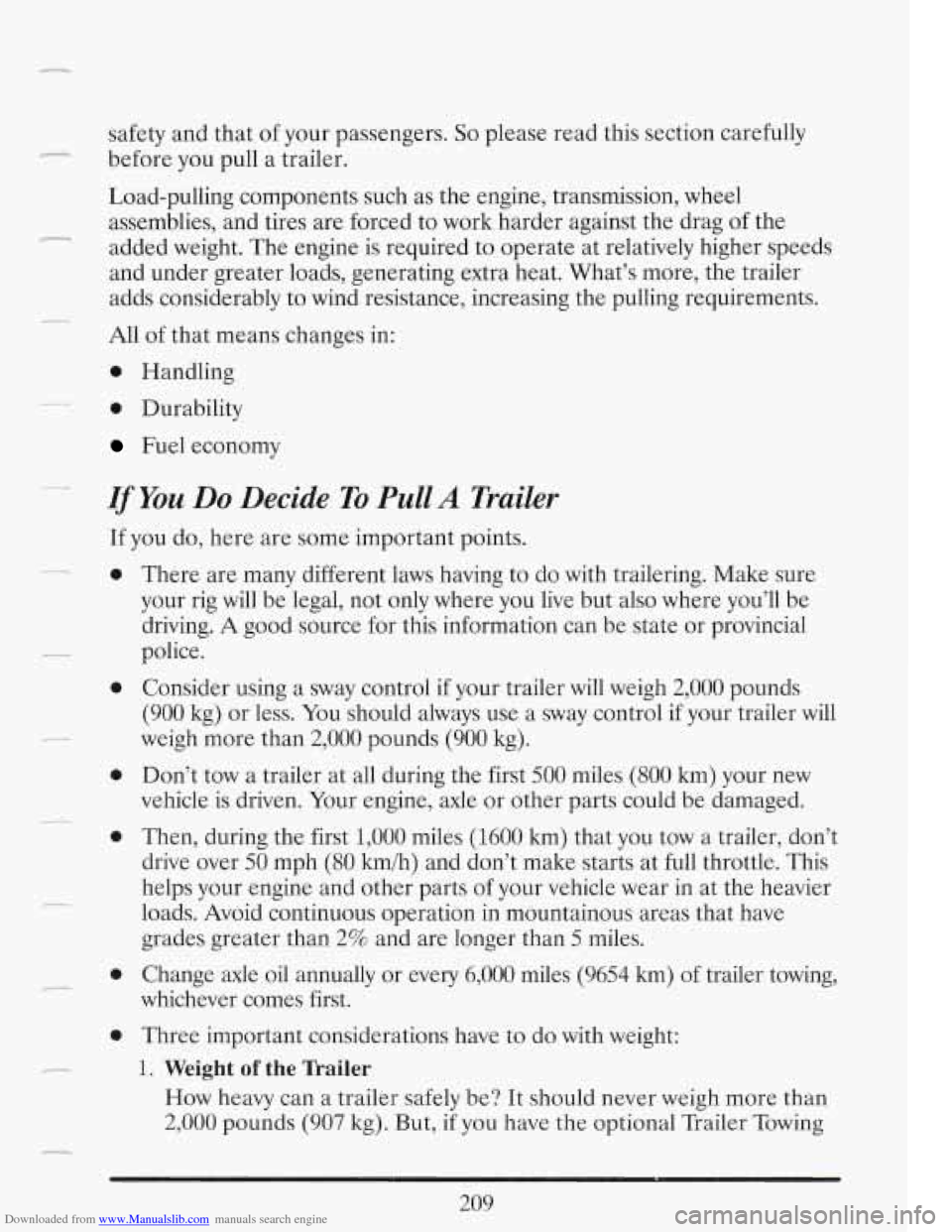
Downloaded from www.Manualslib.com manuals search engine *_
safety and that of your passengers. So please read this section carefully
before you pull a trailer.
Load-pulling components such as the engine, transmission, wheel
assemblies, and tires are forced to work harder against the drag
of the
added weight. The engine is required to operate at relatively higher speeds
and under greater loads, generating extra heat. What’s more, the trailer
adds considerably to wind resistance, increasing the pulling requirements.
All of that means changes in:
0 Handling
0 Durability
Fuel economy
If You Do Decide To Pull A Trailer
If you do, here are some important points.
0
0
0
0
0
0
There are many different laws having to do with trailering. Make sure
your rig will be legal, not only where you live but also where you’ll be
driving.
A good source for this information can be state or provincial
police.
Consider using a sway control if your trailer will weigh
2,000 pounds
(900 kg) or less. You should always use a sway control if your trailer
will
weigh more than 2,000 pounds (900 kg).
Don’t tow a trailer at all during the first 500 miles
(800 km) your new
vehicle is driven. Your engine, axle or other parts could be damaged.
Then, during the first
1,000 miles (1600 km) that you tow a trailer, don’t
drive over
50 mph (80 km/h) and don’t make starts at full throttle. This
helps your engine and other parts of your vehicle wear in at the heavier
loads. Avoid continuous operation
in mountainous areas that have
grades greater than
2% and are longer than 5 miles.
Change axle
oil annually or every 6,000 miles (9654 km) of trailer towing,
whichever comes first.
Three important considerations have to do with weight:
1. Weight of the nailer
How heavy can a trailer safely be? It should never weigh more than
2,000 pounds (907 kg). But, if you have the optional Trailer Towing
Page 225 of 386
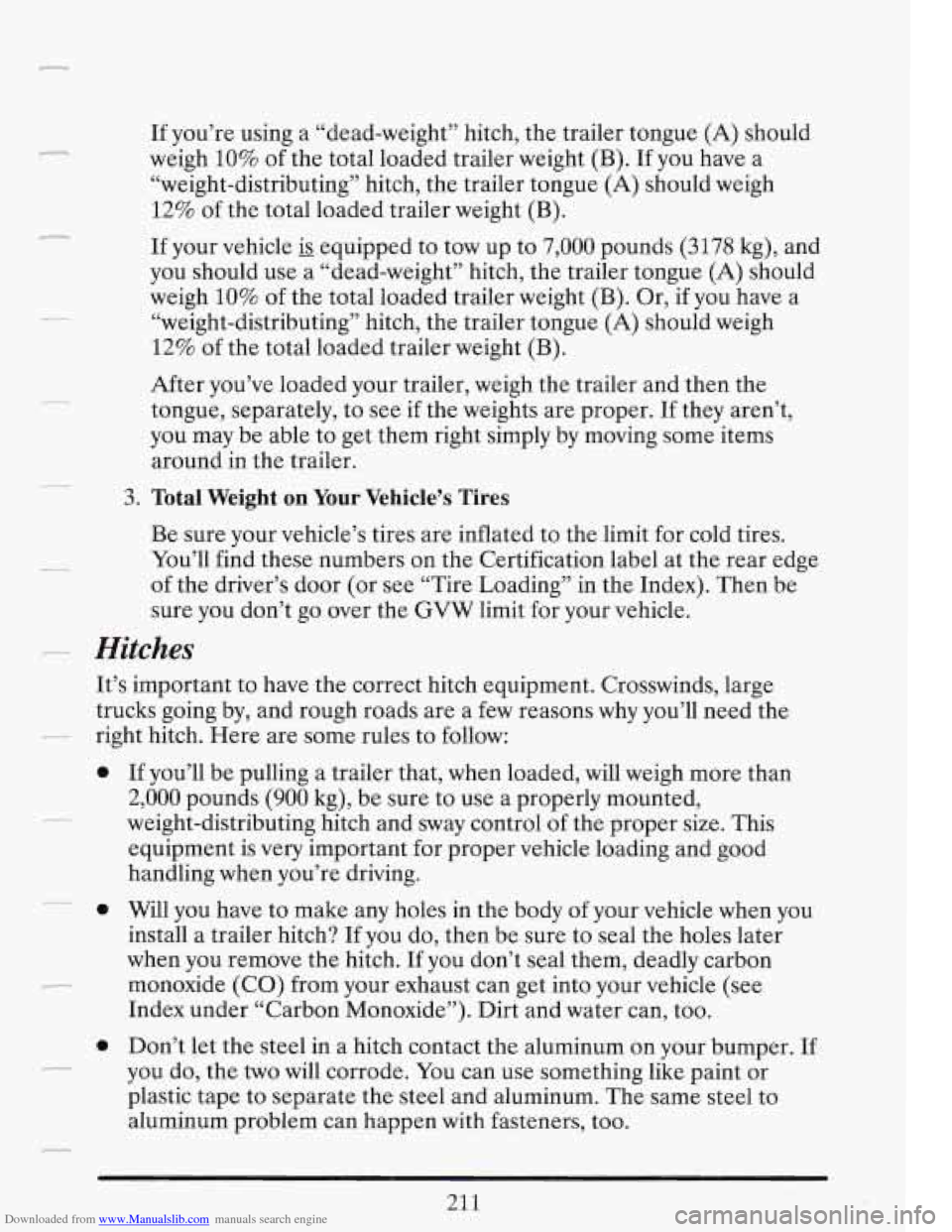
Downloaded from www.Manualslib.com manuals search engine r
r
c-
If you’re using a “dead-weight” hitch, the trailer tongue (A) should
weigh
10% of the total loaded trailer weight (B). If you have a
“weight-distributing” hitch, the trailer tongue
(A) should weigh
12% of the total loaded trailer weight (B).
If your vehicle
is equipped to tow up to 7,000 pounds (3178 kg), and
you should use a “dead-weight” hitch, the trailer tongue
(A) should
weigh
10% of the total loaded trailer weight (B). Or, if you have a
“weight-distributing” hitch, the trailer tongue
(A) should weigh
12% of the total loaded trailer weight (B).
After you’ve loaded your trailer, weigh the trailer and then the
tongue, separately, to see
if the weights are proper. If they aren’t,
you may be able to get them right simply by moving some items
around in the trailer.
3. Total Weight on Your Vehicle’s Tires
Be sure your vehicle’s tires are inflated to the limit for cold tires.
You’ll find these numbers on the Certification label at the rear edge
of the driver’s door (or see “Tire Loading” in the Index). Then be
sure you don’t go over the
GVW limit for your vehicle.
- Hitches
It’s important to have the correct hitch equipment. Crosswinds, large
trucks going by, and rough roads are a
few reasons why you’ll need the
- right hitch. Here are some rules to follow:
0
0
r
If you’ll be pulling a trailer that, when loaded, will weigh more than
2,000 pounds (900 kg), be sure to use a properly mounted,
weight-distributing hitch and sway control of the proper size. This
equipment is
very important for proper vehicle loading and good
handling when you’re driving.
Will you have to make any holes
in the body of your vehicle when you
install a trailer hitch? If you do, then be sure to seal the holes later
when you remove the hitch. If you don’t seal them, deadly carbon
monoxide (CO) from your exhaust can get into your vehicle (see
Index under “Carbon Monoxide”). Dirt and water can, too.
Don’t let the steel in a hitch contact the aluminum on your bumper. If
you do, the
two will corrode. You can use something like paint or
plastic tape to separate the steel and aluminum. The same steel to
aluminum problem can happen with fasteners,
too.
21 1
Page 226 of 386
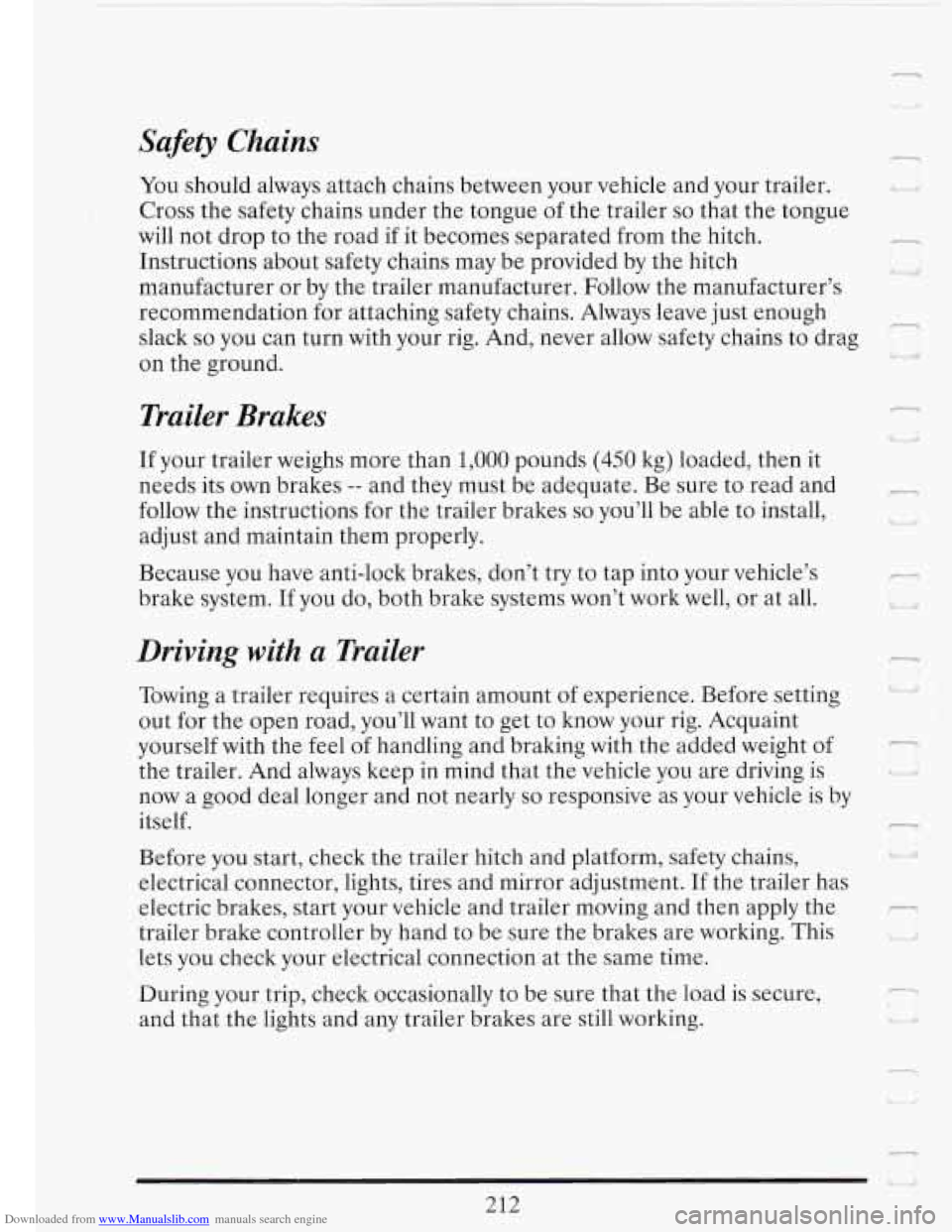
Downloaded from www.Manualslib.com manuals search engine Safety Chains
You should always attach chains between your vehicle and your trailer.
Cross the safety chains under the tongue
of the trailer so that the tongue
will not drop to the road if it becomes separated from the hitch.
Instructions about safety chains may be provided by the hitch
manufacturer or by the trailer manufacturer. Follow the manufacturer’s
recommendation for attaching safety chains. Always leave just enough
slack
so you can turn with your rig. And, never allow safety chains to drag
on the ground.
-
,-
Trailer Brakes
If your trailer weighs more than 1,000 pounds (450 kg) loaded, then it
needs its
own brakes -- and they must be adequate. Be sure to read and
follow the instructions for the trailer brakes
so you’ll be able to install,
adjust and maintain them properly.
Because
you have anti-lock brakes, don’t try to tap into your vehicle’s
brake system. If you do, both brake systems won’t work well, or at all.
Driving with a Trailer
Towing a trailer requires a certain amount of experience. Before setting
out for the open road, you’ll want to get to know your rig. Acquaint
yourself with the feel of handling and braking with the added weight of
the trailer. And always keep
in mind that the vehicle you are driving is
now a good deal longer and not nearly
so responsive as your vehicle is by
itself.
-
Before you start, check the trailer hitch and platform, safety chains, ..
electrical connector, lights, tires and mirror adjustment. If the trailer has
electric brakes, start your vehicle and trailer moving and then apply the
trailer brake controller by hand to be sure the brakes are working. This
lets you check your electrical connection at the same time.
During your trip, check occasionally to be sure that the load
is secure,
and that the lights and any trailer brakes are still working.
212
Page 237 of 386
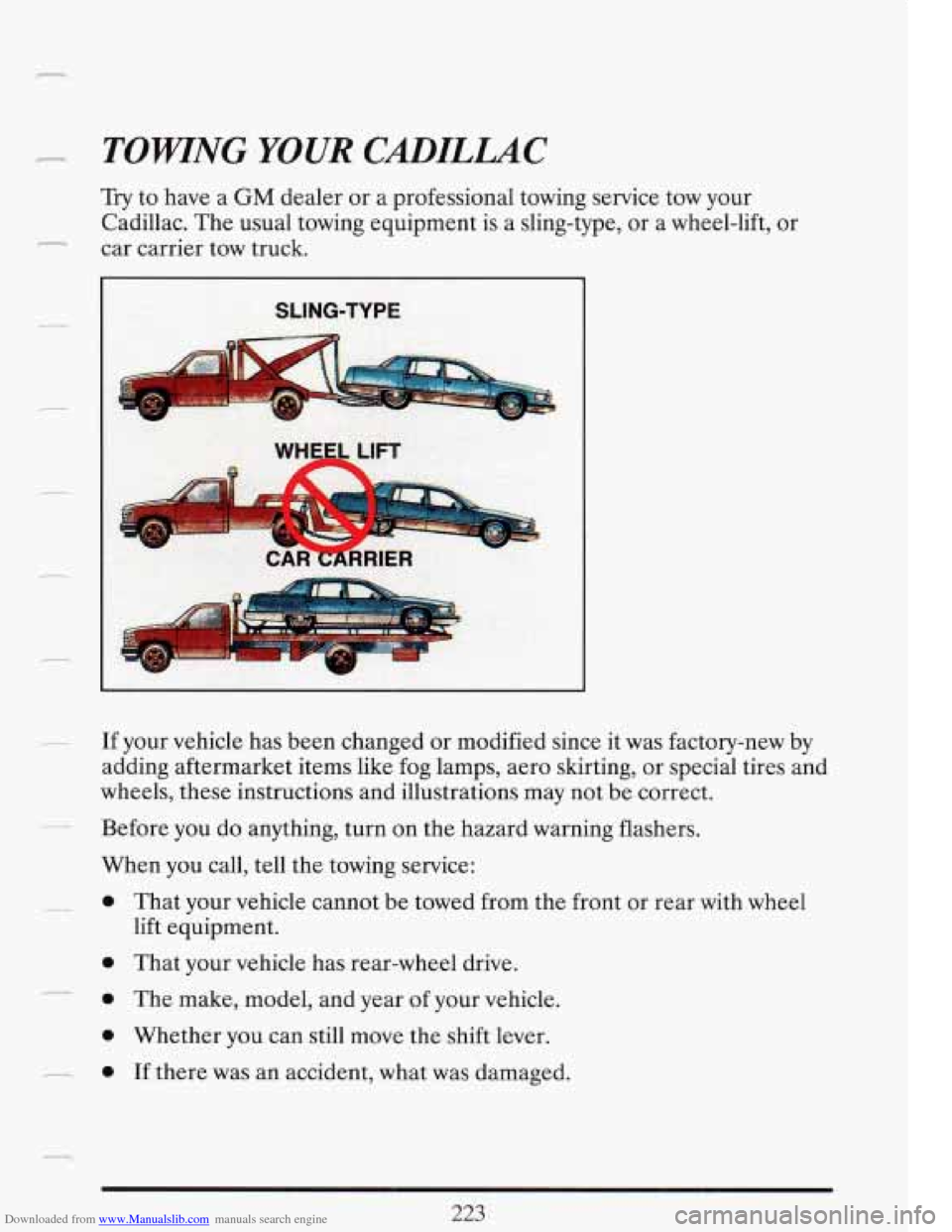
Downloaded from www.Manualslib.com manuals search engine TOWNG YOUR CXDILLAC
Try to have a GM dealer or a professional towing service tow your
Cadillac. The usual towing equipment
is a sling-type, or a wheel-lift, or
car carrier tow truck.
If your vehicle has been changed or modified since it was factory-new by
adding aftermarket items like fog lamps, aero skirting,
or special tires and
wheels, these instructions and illustrations may not be correct.
-- Before you do anything, turn on the hazard warning flashers.
When you call, tell the towing service:
0
0
0
-0
-
That your vehicle cannot be towed from the front or rear with wheel
lift equipment.
That your vehicle has rear-wheel drive.
The make, model, and year
of your vehicle.
Whether you can still move the shift lever.
If there was an accident, what was damaged.
223
Page 251 of 386

Downloaded from www.Manualslib.com manuals search engine 8. Then replace the
pressure cap. Be
sure the arrows on
the pressure cap
line up like this.
IF A TIRE GOES FLAT
-- It’s unusual for a tire to “blow out” while you’re driving, especially if you
maintain your tires properly. If air goes out of a tire, it’s much more likely
to leak out slowly. But
if you should ever have a “blowout,” here are a
If a front tire fails, the flat tire will create a drag that pulls the vehicle
toward that side. Take your foot
off the accelerator pedal and grip the
to a stop well out of the traffic lane.
A rear blowout, particularly on a curve, acts much like a skid and may
remove your foot from the accelerator pedal. Get the vehicle under
control by steering the way you want the vehicle to go. It may be
very
the road if possible.
__ few tips about what to expect and what to do:
__ steering wheel firmly. Steer to maintain lane position, then gently brake
__ require the same correction you’d use in a skid. In any rear blowout,
__ bumpy and noisy, but you can still steer. Gently brake to a stop, well off
If your tire goes flat, the next section shows how to use your jacking
--- equipment to change a flat tire safely.
CHMGING A FLAT TIRE
._- If a tire goes flat, avoid further tire and wheel damage by driving slowly to
a
level place. Turn on your hazard warning flashers.
237
Page 263 of 386
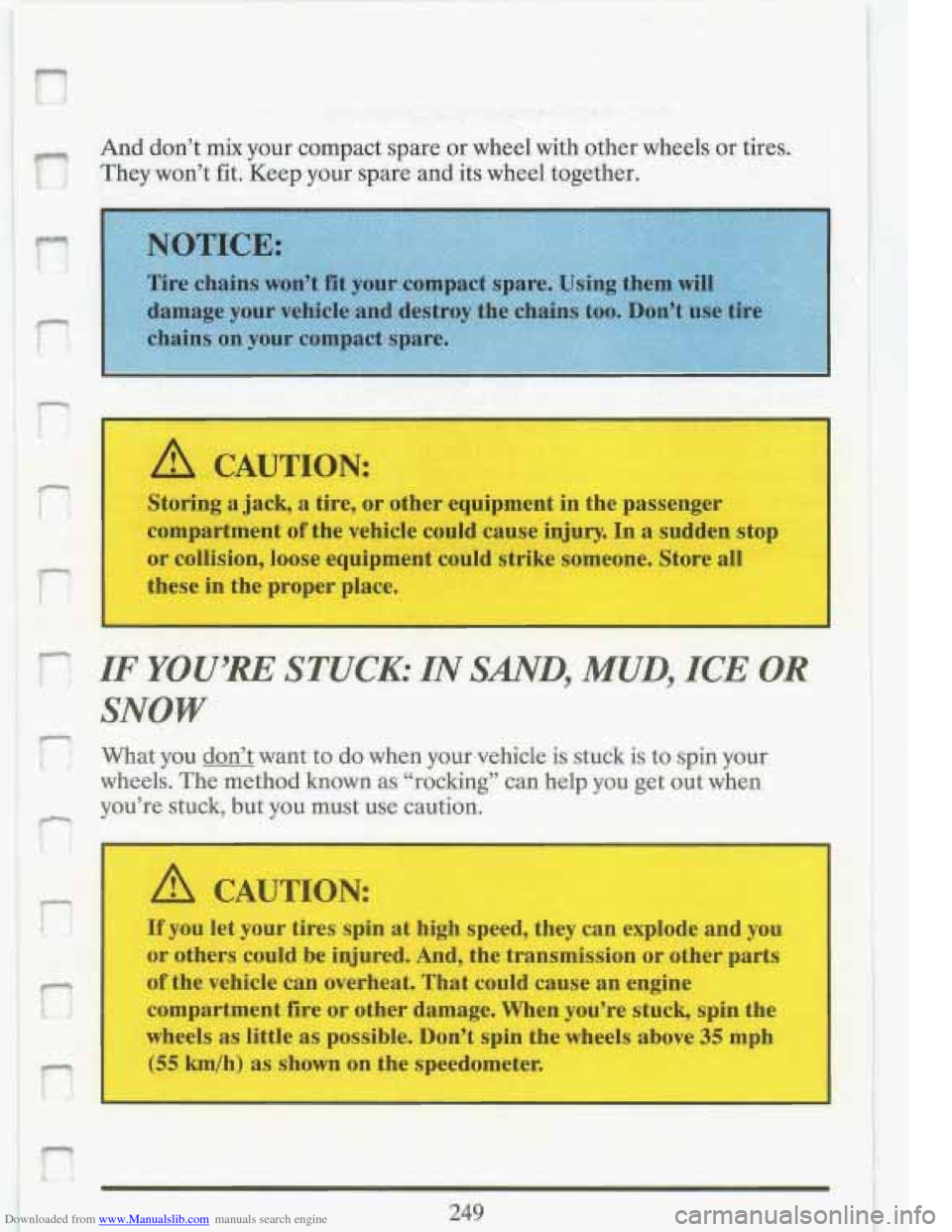
Downloaded from www.Manualslib.com manuals search engine And don't mix your compact spare or wheel with other wheels or tires.
They won't
fit. Keep your spare and its wheel together.
. - ':.-
'. * , F, . - ;,:: .-
Storing a jack, a tire, or other equipment in the passenger
compartment of the vehicle could cause injury. In
a sudden stop
or collision, loose equipment could strike someone. Store
all
these in the proper place.
,.-IF YOU'RE STUCK: IN SAND, MUD, ICE OR
at you don't want to do when your vehicle is stuck is to spin your
wheels. The method known
as "rocking" can help you get out when
Tw're stuck, but you must use caution.
A CAUTION:
If you let your tires spin at high speed, they can explode and you
or others could be injured. And, the transmission
or other parts
of the vehicle can overheat. That could cause an engine
compartment fire or other damage. When you're stuck, spin the
wheels as little as possible. Don't spin the wheels above
35 mph
(55 km/h) as shown on the speedometer.
I
i